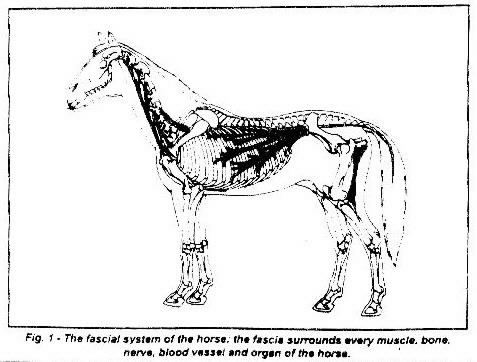 |
||||||||||||||||||||||||
|
|
||||||||||||||||||||||||
 |
||||||||||||||||||||||||
 |
||||||||||||||||||||||||
|
||||||||||||||||||||||||
 |
 |
|
MYOFASCIAL RELEASE AND THE EQUINE ATHLETE |
|
Myofascial release has been used for many years to successfully treat musculoskeletal dysfunction in humans. It has proven to be extremely effective in elongating foreshortened connective tissue and restoring functional movement. In my human practice that involves treating professional and elite athletes myofascial release has been an important tool in my armament for facilitating strength, power and coordination for these high level athletes. Over the last eight years I have been utilizing this technique for the treatment of racehorses and getting amazing results. Just like the professional athlete, the performance horse sustains injuries that have resultant soft tissue tightening and compensatory neuromuscular activity. The Anatomy and Physiology of Fascia The fascia is a tough connective tissue which spreads throughout the body in a three-dimensional web from head to hoof without interruption (Fig. 1). The fascia surrounds every muscle, bone, nerve, blood vessel, and organ, all the way down to the cellular level. Fascia at the cellular level (ground substance) creates the interstitial spaces and functions to support and protect the cell, separate cell from cell, and allow cellular metabolism, respiration, and elimination. In other words, it is the immediate environment of every cell of the body. The fascial system has three basic components: ground substance mentioned above, collagen, and elastin. Generally, the fascial system is one of support, stability, and cushion, forming ligaments, tendons, and fascial sheaths. It is also a system of locomotion and dynamic flexibility forming muscle. |
 |
|
The Response of the Fascial System to Trauma As in humans, the tightening of the fascial system is a protective mechanism that is a response to trauma. This trauma may arise from an acute injury like a tendon strain, chronic compensatory muscular work, or repetitive injury from poor training techniques. The fascia loses its pliability, becomes restricted and is a source of tension for the rest of the body. This loss of pliability is further exacerbated by an inflammatory process. The ground substance solidifies, the collagen becomes dense and fibrous, and the elastin loses its resiliency. These fascial restrictions slowly affect the quality and quantity of motion available to the horse. Over time this can lead to poor muscular biomechanics, altered structural alignment and decreased strength and endurance. This tightening will also produce overuse muscular compensations. Resultant is decreased performance and functional capacity of the horse. Myofascial Release Treatment Myofascial release is a hands-on technique that facilitates a stretch into restricted soft tissues. A sustained pressure is applied into the tissue barrier after 90-120 seconds the first release will be felt. The practitioner follows the release into a new tissue barrier and holds. After a few releases are felt the tissue will become soft and pliable. This restoration of length and health to the myofascial tissues will take the pressure off the pain sensitive tissue like nerves and blood vessels, as well as restore alignment and mobility to the joints. By elongating the fascial system we can restore the efficiency within the neuromuscular elements and proper mechanical length of the connective tissues. Therefore restoring the natural abilities of coordination, strength and power to the horse. We have had a great success with this treatment approach especially when utilized with other treatment techniques such as joint mobilization, therapeutic exercise programs and modalities. The combination of these techniques are beneficial in creating pain free performance, There are many types of equine sporting events with their unique types of injuries to the horse, both acute and chronic. The biomechanics of proper movement for these various events can be observed, analyzed and addressed therapeutically. It is an exciting new field that can be approached from a problem solving, comprehensive, professional program of treatment. ( Reprinted with permission from the John Barnes Institute, Paoli, PA ) |
| [Home] |
|
This website last updated on 31 July 2010 This website is entirely funded by Windsong Therapy and Wellness, Inc. |
|
Disclaimer: Confidentiality of data relating to individual patients and visitors, including their identity, is respected by this Web site. The owners of this Web site undertake to honor or exceed the legal requirements of medical / health information privacy that apply in Texas and the United States. The information on this Web site is Copyright © 1999-2008 Windsong Therapy and Wellness, Inc. Please obtain permission from Windsong Therapy and Wellness, Inc. before reproducing any information from this Web site. |